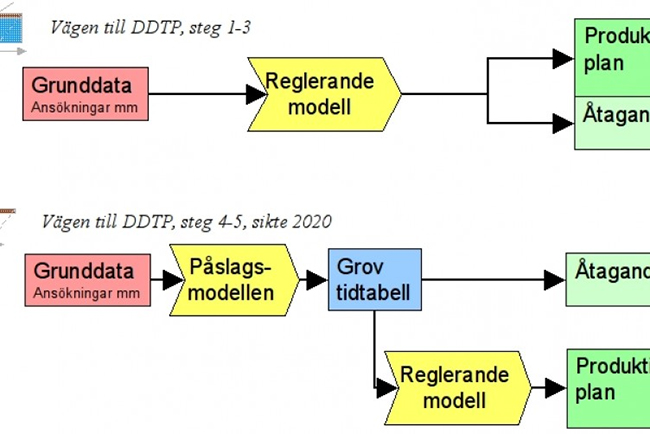DDTP - The Dynamic timetable

DDTP based on a division of the annual timetable in a leveranstågplan and one or more produktionstagplaner. Leveranstagplanen specifying what the Rail Administration undertakes to the railway companies, while produktionstagplanerna be developed to realize the commitment. During DDTPs first year we delivered the first version of the contents of leveranstågplanen and approaches and methods for the corresponding produktionstågplan. The project's continued focus on rolling planning and revision, which is necessary to provide flexibility in the rail system while better meet the demands for punctuality and reliability.
Background
In order to eventually survive the railways must increase its competitiveness against other modes of transport. The railway's competitive advantages and the potential lies in the environmental advantages, security, the ability to scale and thus cost-effectiveness and speed of the communities served.
The first two points are oomtivistade while the last two must be continuously monitored and improved to railway should increase its attractiveness to the transport customers. Together, these advantages that the railway will be competitive, and continues to be a sustainable and safe transport system.
The railway attracts customers is highly dependent on
timeliness and reliability of transport
that there is transport at times when the buyer need them, and that they are sufficiently time-effective
that transport is cost effective.
Punctuality of transport, ie the relationship between what the customer perceives as promised slot and the actual slot, is a very important component in the overall quality of rail transport offers. Punctuality is dependent on the timetable, ie the timetable of all train movements, is designed so that the defined hold times is to maintain and disorders can be managed. The working timetable today provide no support for reprogramming and fault management, but on the contrary at a level of detail that is difficult to maintain .
The railway system has a great potential in speed, comfort and cargo capacity, but suffers from a degree of inflexibility. This inflexibility caused partly by rail's inherent dependencies between different resource types (web, vehicle, etc) but is also the result of the method of planning which emerged: detailed planning that seeks to eliminate all sources of error.
We believe that much can be done during the planning process (tågplanearbetet and operational management) to provide the flexibility that has become necessary as the community at large is becoming more and more dynamic and decisions about travel and transport of goods taken late. This in practical terms mean that the timetable needs to be revised more frequently and that the current detailed regulation of train services moved from the planning phase to the operational phase, eg with suborder of paths only when the train performance is known.
For rail transport, this would in turn mean greater demands on the operational management of train running, which leads to higher demands on information basis of, among other things different train time performance (freight varies from time to time how long, heavy they are) and the alternative options to the train running. To meet demands for greater flexibility powerful decision support systems and access to relevant information, particularly from transport operators.
purpose
The aim of the project is to investigate how to deviate from the philosophy of a detailed, brand locked, plan on half- or full-year basis, and where the operations control to keep the traffic to the detailed plan. Instead, it is proposed that, in the long term, an approach that is adapted to today's requirements for flexibility introduced. This method is as a starting point to have a rough plan, capacity allocation plan, which focuses on providing space for operational rescheduling. The focus of the plan should be consistent with the objectives of the operations: to ensure that traffic delivery targets achieved.